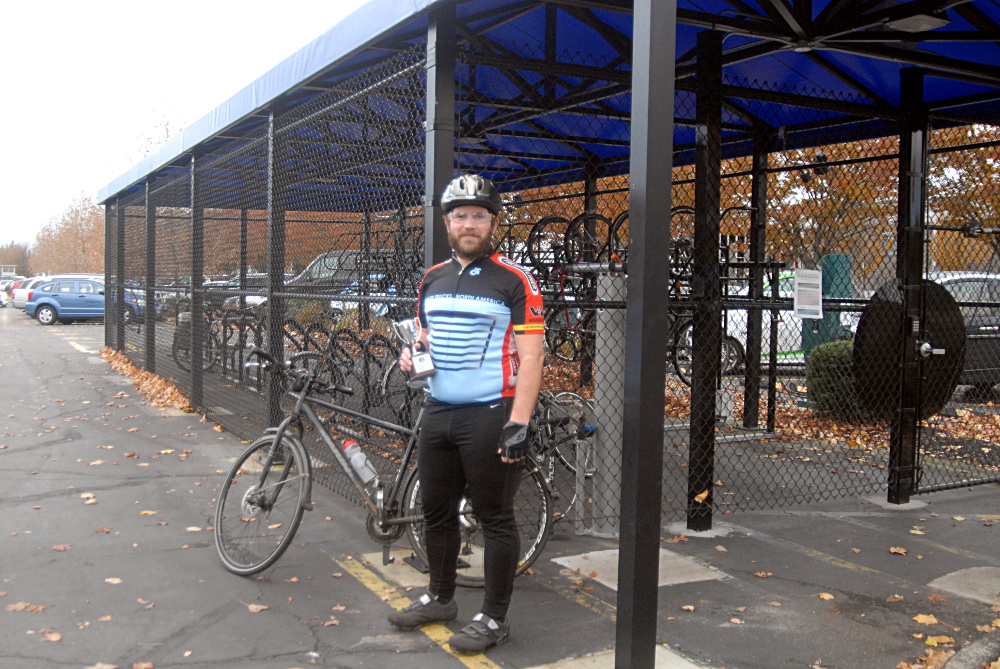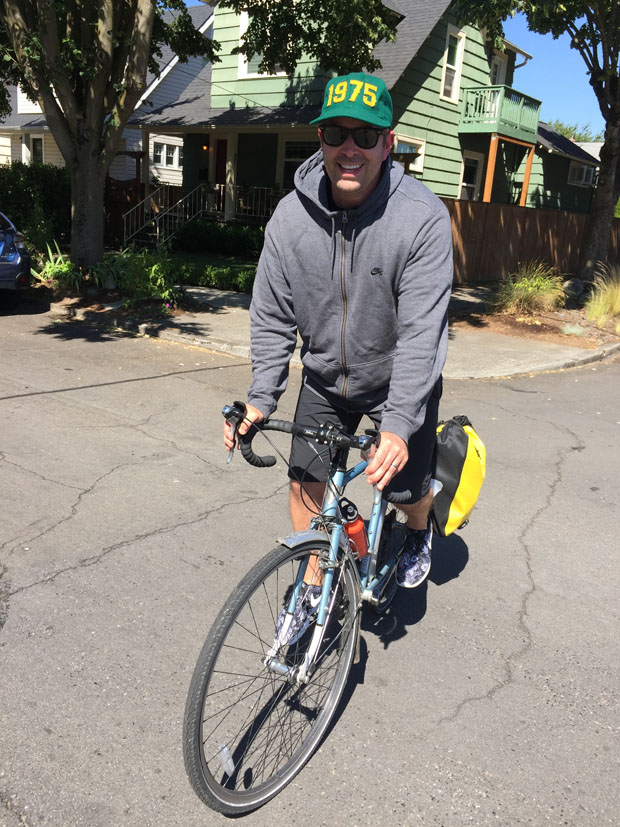 BY KIM MOORE | RESEARCH EDITOR
BY KIM MOORE | RESEARCH EDITOR
Pushing the extreme.
BY KIM MOORE | RESEARCH EDITOR
Pushing the extreme

Kyle Carlson
Four years ago, Kyle Carlson, a senior engineer at Daimler Trucks North America, was looking for ways to lose weight. To get in shape he decided to try cycling part of the 39 miles round trip from his home in Hillsboro to his office on Swan Island in north Portland. At first he took the Max and bus part of the way and cycled the rest. But he soon found it was taking a long time. In 2011, a colleague challenged him to commute the entire distance. And that is what he has been doing ever since.
Now more than 60 pounds lighter, Carlson, 38, aims to commute by bike three times a week. In the summer he stretches out his ride to 55 miles round trip. Last year he won the Bicycle Transportation Alliance’s Bike Commute Challenge distance award for the most miles travelled. The competition, which pits workplace against workplace to see who can bike to work the most during the month of September, was a big “motivator” for Carlson to keep up his commute, he says.
Portland is known as one of the nation’s most popular places to bike to work. Overall bike traffic increased 211 percent between 2000 and 2012, according to the Portland Bureau of Transportation’s bicycle count project. The number of Portland resident commuters increased 40,354 between 2000 and 2013, and 34 percent of those were cyclists, a 284 percent growth on 2000 levels, according to U.S. Census Bureau figures.
But there is also a subset of cyclists that are commuting long distances in Portland’s suburbs, a trend that is set to continue as the metro region’s population expands.
Employers are responding to the increase in bike commuting employees by expanding bike storage facilities and shower and locker rooms. Daimler Trucks North America installed a new covered bike storage cage in the company’s parking lot in 2013 to accommodate the increasing number of its employees biking to work. The facility has room to store 51 bikes and is secured 24/7 with badge-only access. It is also building a new headquarters close by that will include additional interior bike storage and larger shower and locker rooms.
Employees are choosing to commute for the exercise, but are also using it to reduce stress and improve mood. Rex Solin, 57, a cardiovascular technologist at Providence Health & Services, commutes 20 miles each way four to five times a week from Aloha to Providence Portland Medical Center on NE Glisan St. Solin, who has done this commute year round for the past eight years, says biking helps him with his seasonal depression and also with back and shoulder problems.
Solin also estimates he saves $200 per pay period on gas. He would rather bike than sit in traffic. “It is relaxing,” he says, and a good way to avoid sitting in traffic jams. “Portland traffic is getting worse and worse,” he laments. Solin begins his bike commute at 5 a.m. and rides for about one hour and 10 minutes. If he drove it would take him just 15 minutes less time to get to work.
Providence’s employee bike commuting community is growing yearly. It has a bicycle commute group that keeps track of when its caged storage facilities get too crowded and lobbies for more space. The head of the group also gets riders bike discounts and free merchandise.
Bike commuting has become such a normal part of workplace culture that employees are often inspired by their co-workers to cycle to their job. Solin was influenced to bike commute by one of his colleagues, who rode to work every day. He has a couple of concerned co-workers that keep an eye out for him. “If they don’t see me in the morning they check up on me.”
Washington County has a large and growing bike commuting community. Robin Straughan, a sustainability coordinator at the county, commutes by bike from Beaverton to the county’s headquarters in Hillsboro, a distance of around 12 miles each way. She used to commute from Wilsonville – 28 miles one way. But biking this distance became unsustainable, so she moved in May to Beaverton to be closer to work. “It has been a good lifestyle choice. I feel fortunate to have moved close enough to bike to work,” she says. Straughan enjoys the “bike camaraderie” at the county. “It is fairly male dominant, but that is changing,” she says.

Justin Gast | photo courtesy of M.Andersen/BikePortland
Safety can be an issue for commuters that are cycling in the Portland area suburbs where infrastructure, such as designated bike lanes, are fewer than in the city. Justin Gast, 38, a recycling specialist with Washington County, commutes 24 miles in the mornings from Portsmouth in north Portland to Hillsboro. In the evenings he takes the Max part of the way home to Goose Hollow and bikes the remaining 10 miles. Gast bikes along highways in Washington County, a fact he says can be off putting for some people.
“Washington County is doing a lot to make lanes safer. But for a lot of folks they would be scared,” says Gast. He has done this commute for the past five years and noticed more cars on the road as well as more cyclists. Gast chooses to commute to work partly because he finds road traffic so frustrating. “The traffic situation in our area is not getting any better,” he says. “I can never see myself being a car commuter.”
Portland’s population is expected to grow by 280,000 in the next decade, creating a transportation headache for city planners. The Portland Bureau of Transportation is heading an initiative to create a network of biking and pedestrian trails in Portland city center and the central eastside to encourage people to commute by bike and public transit instead of driving.
In the suburbs, changes to make bike commuting safer is progressing, though in Washington County there is recognition of gaps, says Mike Dahlstrom, a senior planner at Washington County. Dahlstrom, 65, rides his bike 13 miles each way from Raleigh Hills to Hillsboro four to five times a week. He is lucky to be able to use bike lanes for most of the distance. But there are roads in the county that can be hairy for cyclists, he says, such as the Tualatin Valley Highway, a five-lane, high-speed road, which Dahlstrom describes as a “very disconcerting ride.”
Like many large employers, Washington County has bike storage facilities and lockers and showers for its employees – features that are becoming increasingly sought after by Oregon’s workforce. “It is important if you want to attract employees who want to maintain physical activity and employees who want to reduce their carbon footprint,” says Dahlstrom.

Matt Kelly
The environmental benefits of bike commuting are important to Matt Kelly, a procurement director at Nike. Kelly, 48, started commuting the 12 miles from his home in north Portland to the Nike campus in Beaverton 13 months ago. Aside from lowering his carbon footprint, he says biking allows him to come to work “feeling good and energetic.”
Kelly says his employer encourages biking to work, providing showers and lockers for employees. As Nike grows it is also putting more stock in alternative forms of transportation for its employees, says Kelly. Nike is expanding its world headquarters campus near Beaverton with two new large office buildings. “I am lucky to work for a company that emphasizes fitness. It encourages biking and walking,” he says.
Kelly notices a big difference in the safety of the roads in Beaverton compared with Portland. “It is quite safe until you hit Beaverton where the traffic moves faster,” says Kelly. “In Beaverton there are bike lanes; it is more about the flow of traffic at an accelerated pace.”
Nevertheless, Kelly enjoys the feeling of freedom and energy that bike commuting has given him. “It is fun. I work for a company that espouses the benefits of sport. It makes [sense] that I live that way.”


 BY KIM MOORE | RESEARCH EDITOR
BY KIM MOORE | RESEARCH EDITOR